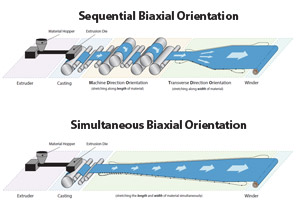

February 15 2022

When it comes to producing biaxially oriented films, most are familiar with the well-proven sequential stretching method, which is used in the production of the vast majority of biaxially oriented film and sheet products. Sequential stretching involves two steps: the first uses a machine direction orienter (MDO ) to stretch the material in the machine direction over a series of rollers, effectively increasing the length and decreasing the thickness of the web. In the second step, a transverse direction orienter (TDO) stretches the film or sheet perpendicular to the MDO stretching in the transverse (cross) direction on a tenter, increasing the width of the web and further decreasing its thickness. These steps are usually undertaken in-line one after the other following extrusion and casting of the web.
Sequential stretching is most often used in the production of material such as BOPS, BOPP, BOPET, BOPLA, and BOPTFE. The primary advantage of this method is that it provides a lot of flexibility in process conditions (e.g. MD and TD stretch ratios) and a high production rate. It is also relatively cost effective.
Despite its prevalence, however, sequential stretching does have a shortcoming. The fact that it stresses the material several times over limits its ability to process few materials and involves direct contact with the machine rolls which can actually compromise the optical quality of the film.
An Alternative for Special Film Properties
There is another, less common technique that’s ideal for certain plastic film and sheet applications, particularly if the material does not tolerate sequential stretching in separate steps or must have exceptional optical properties. This technique is called the simultaneous stretching method. It combines MDO and TDO into a single-step stretching process using a very specialized tenter.
During simultaneous stretching, the web is restrained in the tenter clips and suspended in air while being stretched in both the machine and transverse directions. This allows for improved optical and mechanical properties. Applications that may call for simultaneous orientation include primarily specialty laminates and optical films (such as those used in touch screen displays) and some specialty polymers that won’t process sequentially. The downside of this method is that it involves a complex and costly system that is difficult to maintain due to an abundance of moving parts. It is also less versatile with respect to process changes.
Fortunately, the majority of film stretching processes don’t require the advanced capabilities that simultaneous stretching provides. Parkinson Technologies focuses on sequential technologies as part of the long history of BIAX film development under our Marshall and Williams Plastics brand of orientation equipment products. These products are substantially more versatile, reliable, and cost-effective for our customers.